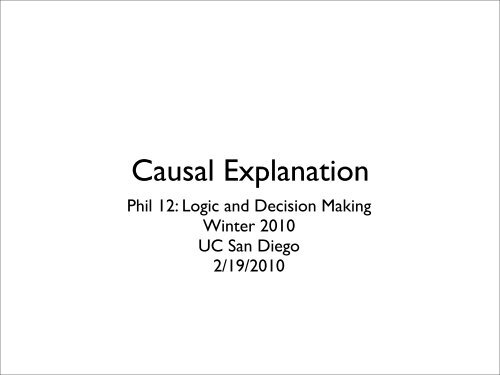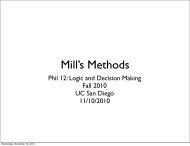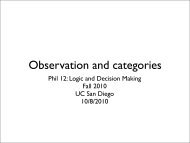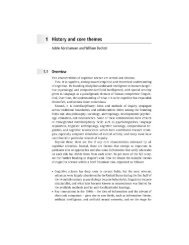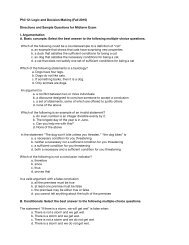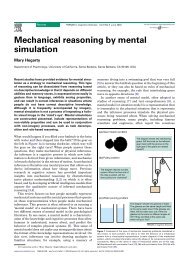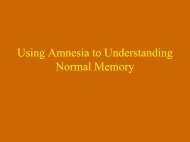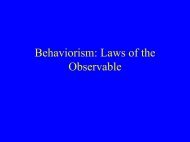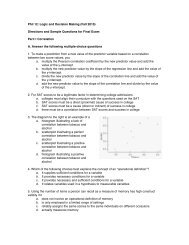Causal Explanation - UC San Diego
Causal Explanation - UC San Diego
Causal Explanation - UC San Diego
You also want an ePaper? Increase the reach of your titles
YUMPU automatically turns print PDFs into web optimized ePapers that Google loves.
<strong>Causal</strong> <strong>Explanation</strong><br />
Phil 12: Logic and Decision Making<br />
Winter 2010<br />
<strong>UC</strong> <strong>San</strong> <strong>Diego</strong><br />
2/19/2010
Review<br />
• Cause: something which brings about or increases the<br />
likelihood of an effect<br />
• Correlations point to and give evidence of causal relations,<br />
but do not themselves demonstrate causation<br />
- Correlation is symmetrical<br />
- Causation is directional<br />
• Differentiate variables when investigating causal hypotheses:<br />
- Independent variable: possible cause, what is<br />
manipulated<br />
- Dependent variable: possible effect, depends on the<br />
independent variable
Review<br />
• Strongest evidence for causation comes from<br />
experiments<br />
- Manipulate the independent variable and<br />
detect effect on the dependent variable<br />
- Speak of manipulated independent variable<br />
• When manipulation is not possible<br />
- Measured independent variable<br />
• In either case, the dependent variable is<br />
measured
Correlation without Direct Causation<br />
• Sometimes one variable is directly related causally to<br />
another. But sometimes the causation is via some<br />
other link<br />
- Ice cream sales and the number of shark attacks on<br />
swimmers are correlated<br />
- SAT scores and college grades are correlated<br />
- Skirt lengths and stock prices are highly correlated<br />
(as stock prices go up, skirt lengths get shorter)<br />
- The number of cavities in elementary school<br />
children and vocabulary size have a strong positive<br />
correlation
•<br />
•<br />
- accident-prone drivers prefer red<br />
- people become more aggressive when driving red<br />
- more dangerous cars tend to be painted red (sports<br />
- the color red is harder to see and is more likely to<br />
When causation is<br />
suspected<br />
Driving red cars is positively correlated with having<br />
traffic accidents<br />
Why? Several possible causal scenarios<br />
cars<br />
cars)<br />
be involved in a 2-car accident
Extraneous Variables<br />
• Given the number of possible variables to consider, in<br />
any given sample some will be correlated with the<br />
dependent variable of interest<br />
• If these are not the variables we are focusing on, we<br />
term them extraneous<br />
• But:<br />
- What we term extraneous may in fact be the<br />
causally relevant variable<br />
- So, care must be taken to rule out any causal link<br />
between these extraneous variables and the<br />
dependent variable
•<br />
•<br />
•<br />
Limits of Correlation<br />
Fluoride in water is correlated with lower rate<br />
of tooth decay<br />
- Fluoride reduces cavities<br />
- People in cities with fluoride enjoy better diets<br />
- People in cities with fluoride practice better dental hygiene<br />
- People in cities with fluoride have better genetics<br />
- Water in cities with fluoride contains other minerals<br />
But why?<br />
(calcium) that help prevent tooth decay<br />
These additional variables are extraneous from the point of<br />
view of the first hypothesis, but they might be the true causes
Investigating causes<br />
• If a causal relation exists between two<br />
variables, then if we can directly manipulate<br />
values on one (the independent variable), we<br />
should change values on the other (the<br />
dependent variable)<br />
• An experiment is precisely an attempt to<br />
demonstrate causal relations by manipulating<br />
the independent variable and measuring the<br />
change on the dependent variable.
The Logic of <strong>Causal</strong> Research<br />
• To confirm or falsify a causal claim based on a correlation, we use<br />
modus tollens. The first premise in each case, though, is different<br />
• Confirming a causal claim:<br />
If X is not a cause of Y [and there is no alternative plausible<br />
hypothesis], then there will not be a statistically significant<br />
difference in Y when X is present.<br />
There is a statistically significant difference in Y when X is<br />
present [and there is no alternative plausible hypothesis].<br />
! X is a cause of Y.<br />
• Whether the first premise is true depends critically on how we<br />
set up the test of the causal hypothesis—whether we make it<br />
very unlikely that anything else could produce a difference in Y
•<br />
•<br />
Avoiding Affirming the<br />
Don’t use this argument:<br />
Consequence<br />
If X is a cause of Y, then there will be a statistically<br />
significant difference in Y when X is present.<br />
There is a statistically significant difference in Y when<br />
X is present.<br />
! X is the cause of Y.<br />
It is invalid!
The Logic of <strong>Causal</strong> Research - 2<br />
• Falsifying a causal claim:<br />
If X were the cause of Y [and auxiliary assumptions<br />
are true and the experimental set up is adequate],<br />
then there would be a statistically significant difference<br />
in Y when X is present.<br />
There is no statistically significant difference in Y when<br />
X is present [and auxiliary assumptions are true and<br />
the experimental set up is adequate]. !<br />
! ! X is not the cause of Y<br />
• The truth of the first premise depends critically on how<br />
we set up the test of the causal claim
•<br />
•<br />
Seeing Causes<br />
A tradition in philosophy, whose<br />
roots lie with David Hume, maintains<br />
that we never see causation, only<br />
events preceding other events<br />
But some visual displays such as<br />
those developed by Albert Michotte<br />
are hard to see in any other way
Describe what you see
•<br />
•<br />
•<br />
What is a cause?<br />
A variable, some of whose values bring about or<br />
increase the value of the effect variable<br />
Two more specific notions of cause:<br />
- The cause is sufficient to bring about the effect<br />
- The cause is necessary to bring about the<br />
effect<br />
Neither works perfectly, but each is suggestive of<br />
important features of causation and help us<br />
understand how to test causal claims
Recall the Logic of Necessary<br />
and Sufficient Conditions<br />
• Conditional relations between statements captured<br />
with the connective “if, then”<br />
- If the score is tied, then we will play another round<br />
• The score being tied is sufficient for playing another<br />
round<br />
• Playing another round is necessary when the score is tied<br />
- Better captured by:<br />
• Only if we played another round was the score tied<br />
• We can extend the notions of necessary and sufficient<br />
to causes
Sufficient causes<br />
• Examples of factors sufficient to<br />
bring about an effect<br />
- Dead battery is sufficient for car<br />
not starting<br />
- Placing water in a normally<br />
operating freezer is sufficient for<br />
it freezing<br />
- Ingesting (enough) hemlock is<br />
sufficient for dying<br />
- Increased exercise without eating<br />
more is sufficient for weight loss.
The value of sufficient causes<br />
• A sufficient cause gives us a<br />
recipe for producing an effect we<br />
want<br />
- If you don’t want someone to<br />
drive your car, totally run<br />
down the battery<br />
- If you want to lose weight,<br />
exercise
The difficulty with sufficient causes<br />
•<br />
For many conditions in which<br />
you think you have found a<br />
sufficient cause, an exception can<br />
be found<br />
- If you take an antidote with<br />
- If you put salt in the water, it<br />
your hemlock (should one be<br />
found), you might escape death<br />
may not freeze even when<br />
temperature is less than 32!
The difficulty with sufficient causes<br />
• Few factors we identify as causes are really sufficient<br />
to bring about their effect<br />
- They suffice only in the context of background<br />
conditions that are assumed to be in place<br />
• Turning the ignition switch will start the car<br />
only if it is hooked up to the rest of the<br />
ignition system, there is an engine in the<br />
car, there is gas, oxygen is available, . . .<br />
• Often need to specify a conjunction of<br />
factors to arrive at a sufficient cause<br />
- and it is very difficult to note all of them
Necessary causes<br />
• Something that is necessary to<br />
produce an effect:<br />
- Sex is necessary for producing babies<br />
- Oxygen is necessary for combustion<br />
- Herpes zoster is a necessary cause<br />
of chickenpox<br />
- Early exposure to language is<br />
necessary for normal language<br />
development
For want of a...<br />
• For want of a nail, the shoe<br />
was lost,<br />
• For want of the shoe, the<br />
horse was lost,<br />
• For want of the horse, the<br />
rider was lost,<br />
• For want of the rider, the<br />
battle was lost,<br />
• For want of the battle, the<br />
kingdom was lost,<br />
• And all for the want of a<br />
horseshoe nail!
The value of necessary causes<br />
• Provide a way of preventing<br />
something<br />
- Avoiding sex does prevent<br />
babies (and AIDs)<br />
- Eliminating oxygen does stop<br />
fires<br />
- Keeping Herpes zoster away<br />
from you prevents chickenpox
The difficulty with necessary causes<br />
• For many supposed necessary causes, there are<br />
alternatives<br />
- Sex is not strictly<br />
necessary for<br />
producing babies—in<br />
vitro fertilization can<br />
replace it
Sufficient<br />
Causes<br />
Necessary<br />
Causes<br />
Quick<br />
description<br />
A sufficient cause<br />
can bring about an<br />
effect, (e.g.<br />
ordinarily, pulling a<br />
trigger of a loaded<br />
gun suffices to fire a<br />
gun).<br />
A necessary cause is<br />
a precondition that<br />
must obtain for the<br />
effect to manifest,<br />
(e.g. guns need a<br />
hammer to fire.)<br />
Recap<br />
Value of<br />
identifying<br />
If we know sufficient<br />
causes, we can be<br />
empowered to bring<br />
about desired<br />
effects, (e.g. if we<br />
know how to fire<br />
the gun, we can.)<br />
If we know<br />
necessary causes, we<br />
can prevent effects,<br />
(e.g. remove the<br />
hammer and the gun<br />
will not fire).<br />
Inadequacy as a<br />
full<br />
characterization<br />
of ‘cause’<br />
Events which we may<br />
want to call causes<br />
aren’t strictly speaking<br />
sufficient, since we<br />
can imagine contexts<br />
in which the causes<br />
fail to suffice, (e.g.<br />
pulling a trigger fires a<br />
gun, but not if the<br />
bullets are duds).<br />
Preconditions don’t do<br />
anything (just because<br />
a gun has all its parts,<br />
doesn’t mean it will<br />
fire.)<br />
Practical<br />
difficulties<br />
Sufficient conditions are<br />
difficult to identify, and,<br />
perhaps, impossible to<br />
perfectly specify, since<br />
such a specification would<br />
require an exhaustive<br />
description of the<br />
relevant background<br />
conditions.<br />
Necessary conditions<br />
are also difficult to<br />
identify since the<br />
scientific enterprise can<br />
reveal, unexpectedly,<br />
that what was once<br />
supposed necessary is<br />
not (pin firing)
Clicker question 2<br />
Putting a jar over a candle is:<br />
A. A necessary cause for the candle burning<br />
B. A necessary cause for putting out the candle<br />
C. A sufficient cause for putting out the candle<br />
D. Both a necessary and sufficient cause for putting<br />
out the candle
Clicker question 3<br />
To stop an event from happening you should:<br />
A. Eliminate a sufficient cause<br />
B. Supply a sufficient cause<br />
C. Eliminate a necessary cause<br />
D. Supply a necessary cause
Partial or contributory causes<br />
•<br />
•<br />
•<br />
•<br />
Tad: “The problem with our schools is the teachers.<br />
There are too many incompetent teachers who either<br />
don’t know how to teach, or just don’t care about<br />
teaching any more.”<br />
Ruby: “I think parents are a big part of the problem too.<br />
Lots of parents fail to read to their children, never help<br />
them with homework, and don’t make sure their kids<br />
get to bed on time.”<br />
Tad: “So you’re saying bad teachers have nothing to do<br />
with it?”<br />
Ruby: “No, I’m saying parents have a lot to do with it<br />
too.”
Partial or contributory causes<br />
• A factor that increases the likelihood of the<br />
event occurring but may be neither<br />
necessary nor sufficient for the effect<br />
- Viewing TV violence and aggressive behavior<br />
- Icy roads and car accidents<br />
- Genetic factors and heart attacks<br />
- Fast food diet and heart attacks<br />
- Vigorous exercise and heart attacks
•<br />
- This would be an effective counterexample if the claim<br />
- But if the claim is that smoking is a contributory<br />
Uncle John Exception<br />
My uncle John smoked two packs of cigarettes a day for<br />
75 years, and he never got lung cancer. See, smoking<br />
doesn’t cause lung cancer.<br />
were that smoking is a sufficient cause of lung<br />
cancer<br />
cause, one or even many counterexamples are not<br />
telling<br />
•<br />
Rather, what one must do is show that over a<br />
population there is no increase in lung cancer<br />
among those who smoke
Why care about contributory causes?<br />
• Even though changes in contributory causes<br />
cannot either:<br />
- Totally prevent the effect<br />
- Bring about the effect by themselves<br />
• they can significantly increase or decrease the<br />
likelihood of the effect<br />
- Eliminating fast foods from your<br />
diet can reduce the risk of<br />
heart attack
Proximate/ultimate causes<br />
• What was the cause<br />
of the Cedar Fire in<br />
2003?<br />
• A hunter’s flare?
Proximate/ultimate causes<br />
• Failure to remove the<br />
dry brush through<br />
forest thinning?<br />
• Dry conditions
Proximate/ultimate causes<br />
• The growth of<br />
seedlings into<br />
trees?<br />
• The big bang?
•<br />
•<br />
•<br />
Proximate/ultimate causes<br />
There is generally a history of events, each of which plays<br />
a role in bringing about the event of interest<br />
Sometimes we are interested in events in close proximity<br />
to the effect we wish to explain—proximate cause<br />
Sometimes we are interested in events further back in<br />
the chain of causation—ultimate causes<br />
• Proximate and ultimate causes are not<br />
competitors<br />
- They are relevant for different explanatory<br />
projects


